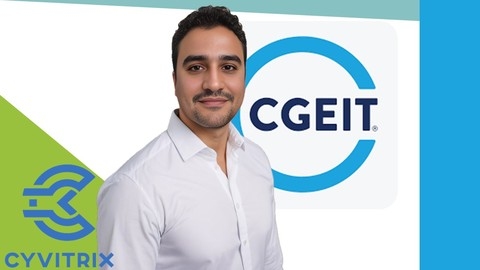IT governance is the framework that ensures IT investments and operations align with an organization’s overall strategies and objectives.
It’s about making sure technology serves the business effectively, managing risks, and optimizing resources.
By learning IT governance, you can contribute to better decision-making, improved performance, and increased value from IT investments.
Whether you’re an IT professional, a business leader, or aspiring to a career in IT management, understanding IT governance is crucial for success in today’s technology-driven world.
Finding a good IT governance course on Udemy can be challenging, given the variety of options available.
You need a course that covers the key concepts, frameworks, and best practices, while also providing practical insights and real-world examples.
You’re looking for expert instruction, engaging content, and a learning experience that fits your specific needs.
We’ve reviewed numerous courses and found IT Governance: A Guide for IT Professionals to be the best course overall on Udemy for IT governance.
This course offers a comprehensive introduction to IT governance, covering key concepts, frameworks, and practical applications.
It’s designed to provide a solid foundation for anyone looking to understand and implement effective IT governance practices.
While this is our top recommendation, there are other valuable courses on Udemy that cater to different learning styles and focus areas.
Keep reading to explore our curated list of the best IT governance courses on Udemy, covering various aspects and levels of expertise.
IT Governance: A Guide for IT Professionals
This IT governance course equips you with a foundational understanding of IT governance, differentiating it from IT management and highlighting its importance in aligning IT with business goals.
You explore the behavioral aspects of governance, learning how to manage its dimensions effectively.
You delve into key IT decision domains—principles, architecture, infrastructure, application needs, and investment prioritization—grasping their interconnectedness and impact on IT strategy.
You also examine six IT governance archetypes, such as Business Monarchy and IT Duopoly, understanding how these models influence organizational decision-making.
You learn to apply the IT Governance Matrix, a tool for clarifying decision and input rights, using the real-world example of DBS Bank.
You analyze how various enterprises govern IT, comparing high-performing organizations with others, and noting differences between public and private sector approaches.
You examine the three core capabilities of IT governance: structural, process, and relational, understanding their influence on organizational success.
This comparative analysis provides valuable insights into current industry practices.
You then explore established IT governance frameworks like COBIT and ITIL, examining their key components, evolution, advantages, and disadvantages.
You gain a strong understanding of COBIT 5, including its five key principles and process model, and learn about the core components of ITIL.
This comparative approach empowers you to select the most appropriate framework for your specific organizational needs.
You gain practical skills and knowledge to implement and manage effective IT governance strategies.
This exploration of frameworks provides practical tools for real-world application.
IT Governance and Information Management
This IT governance course begins with a foundational introduction, setting the stage for a deep dive into the Control Objectives for Information Technologies (COBIT 5) framework.
You’ll discover why COBIT 5 is essential for managing IT risks and aligning technology with business goals.
You’ll grasp its key features and understand its importance in ensuring your technology effectively serves your business needs.
You’ll then explore the five core principles of COBIT 5: meeting stakeholder needs, covering the enterprise end-to-end, applying a single integrated framework, enabling a holistic approach, and separating governance from management.
Through practical exercises and real-world examples, you’ll solidify your understanding of these principles and how they work together to build a strong IT governance system.
You’ll actively apply these principles in various scenarios, gaining valuable hands-on experience.
Next, you’ll delve into the seven enablers of COBIT 5: principles, policies, and frameworks; processes; organizational structures; culture, ethics, and behavior; information; services, infrastructure, and applications; and people, skills, and competencies.
You’ll discover how each enabler contributes to effective IT governance.
You’ll see how these components interact to achieve a holistic approach to IT management.
For instance, you’ll examine how creating effective policies, managing processes efficiently, and fostering a positive IT culture contribute to a robust framework.
You’ll then learn how to put COBIT 5 into action.
The course guides you through a seven-phase implementation lifecycle, providing a practical, step-by-step approach.
You’ll learn about program management, change enablement, and creating business cases to justify IT investments.
You’ll also explore the COBIT 5 Process Capability Model, a tool for assessing and improving your IT processes.
This model helps identify areas for improvement and measure the maturity of your processes, contributing to a continuous improvement cycle.
Master Course in Corporate Governance and IT Governance 2.0
You begin this master course by exploring the foundations of corporate governance and IT governance.
You discover how these two disciplines intertwine to create a stable and ethical business environment, contributing to a company’s overall success.
The course emphasizes the practical application of these concepts, moving beyond theory to provide you with actionable skills.
Next, you delve into the core principles and frameworks that underpin effective governance structures.
This includes understanding how to measure, improve, and evaluate corporate governance processes for continuous improvement.
You also learn how to establish and audit IT governance frameworks, ensuring technology aligns with business objectives and regulatory requirements.
This involves gaining practical skills such as conducting effective IT audits and implementing security solutions to protect sensitive data.
You then connect corporate and IT governance to a company’s bottom line, understanding how these practices directly impact profitability, risk management, and regulatory compliance.
You learn to identify key performance indicators (KPIs) to track progress and demonstrate the effectiveness of your governance strategies.
You finish the course with a solid understanding of how to build and maintain a robust governance structure, setting your organization up for long-term growth and sustainability.
CGEIT Complete Training - Governance of Enterprise IT 2024
This CGEIT training efficiently prepares you for the CGEIT exam by covering the four domains of enterprise IT governance.
You’ll begin with the governance of enterprise IT itself, exploring governance committees, corporate structures, and security governance.
You’ll also delve into strategy building and implementation, learning practical tools like the RACI matrix to manage responsibilities and avoid conflicts of interest.
Developing and implementing effective policies, including AUP, physical security, data protection, BYOD, and network access policies, is a crucial part of this domain.
Real-world examples, such as the shift to remote work during the Covid pandemic, illustrate these concepts.
You’ll learn about governance frameworks like COBIT and how to conduct audits and assessments to ensure effective governance.
You’ll then explore the management of IT resources, encompassing information security, cybersecurity, and GRC functions.
This section covers acquiring new IT solutions, project management, IT asset management, and data lifecycle management, including data destruction techniques.
You’ll examine compliance management within a global security landscape, address privacy regulations, and learn strategies for managing external IT resources through outsourcing.
This domain equips you with the skills to manage IT resources effectively and ensure they align with governance objectives.
The course then focuses on benefits realization, a critical aspect of demonstrating IT’s value.
You’ll explore performance management techniques, using tools like the IT Balanced Scorecard, KPIs, and metrics to measure success.
Configuration management, change management, capacity and portfolio management are also addressed.
You’ll analyze costs using Capex and Opex models and learn how to calculate ROI and ROSI to justify IT investments.
Developing robust budget requests and proposals will further enhance your ability to secure funding and support for IT initiatives.
Finally, you’ll learn about risk optimization, a crucial aspect of IT governance.
You’ll cover key information security terminology, various risk types, and risk management frameworks.
The three lines of defense model provides a practical framework for managing risk, and you’ll learn how to perform risk identification, analysis, and response.
You’ll also delve into threat modeling, abuse cases, supply chain risk management, incident management, and business continuity planning.
Practice exams and quizzes reinforce learning throughout the course, and instructor support is available to answer your questions.
Master (CGEIT) Certified in the Governance of Enterprise IT
This CGEIT course prepares you for the complexities of governing IT in today’s fast-paced business world.
You start with the basics of IT governance, learning why it’s so important for any organization using technology.
The course then introduces you to the CGEIT certification from ISACA, explaining the process and benefits of earning this globally recognized credential.
This gives you a solid foundation before diving into the core material.
You then explore essential IT governance frameworks like COBIT and ITIL.
You learn how to use these frameworks to create IT governance principles and put effective strategies into action.
The course breaks down the five key areas, or domains, of CGEIT, ensuring you grasp each concept thoroughly.
You learn how to align your IT plans with your company’s overall goals, a crucial aspect of strategic management.
The course also teaches you how to get the most out of your IT investments.
You learn practical ways to measure and improve the value you receive from your IT resources.
You also develop skills in risk management, learning how to identify and handle potential IT problems.
You will build a strong system to assess and manage risks in today’s complex IT environments.
Finally, you learn how to effectively manage and optimize IT resources, making the most of your budget and team.
You will analyze real-world case studies that show how successful companies use these principles.
You’ll see examples of effective IT governance, smart risk management, and efficient resource optimization.
This hands-on approach helps you understand the concepts and prepares you for real-world challenges.
Essentials of CGEIT: IT Governance and Certification
You’ll begin by exploring the Certified in the Governance of Enterprise IT (CGEIT) certification itself, understanding its value and what it involves.
The course uses the COBIT framework to explain how IT governance works in practice.
You’ll learn how to connect your IT strategy with your broader business goals, ensuring your technology investments support your organization’s objectives.
You’ll then delve into IT risk management, learning how to identify, assess, and mitigate risks like cybersecurity threats and data privacy breaches.
The course emphasizes optimizing your IT resources, helping you get the most value from your technology investments and boost your return on investment.
You’ll discover practical strategies for improving efficiency within your IT operations.
The course then provides real-world examples of IT governance in action, illustrating the challenges and solutions you might encounter.
You’ll examine the core components and domains of CGEIT, building a strong theoretical base for the ISACA CGEIT certification exam.
This foundation in IT governance principles, combined with your understanding of COBIT, will empower you to implement effective governance practices in any organization.
Implement IT Governance Step by Step
This IT governance course takes you step by step through building a strong IT system.
You start with the basics, learning why IT governance is important and how it connects to your business goals.
The course uses a real-world example, TechSphere Solution, to help you understand.
You also learn about important frameworks and standards that guide IT governance.
This sets you up with a solid understanding of how to make IT work for your business.
Then, you learn how to put IT governance into action.
You begin by looking at your current IT setup and business needs.
This helps you set clear goals and decide what your IT governance plan should cover.
You’ll then build your governance structure, creating policies for making decisions, investing in IT, managing risks, and following rules.
The course covers important procedures for managing your infrastructure, cybersecurity, and data.
You also learn about managing software development, handling changes, and overseeing projects within your governance framework.
From there, you learn how to put your plan into practice, track its success, and keep making it better.
You’ll create documentation for your IT governance structure, so everyone knows how it works.
The course also covers advanced topics, like how to fine-tune your governance and grow leadership within your IT team.
You learn how to prepare for disasters and keep your business running smoothly.
This course prepares you to handle every part of your IT environment effectively, from basic planning to advanced strategy.
Mastering IT Governance with COBIT 2019 and COBIT 5
You’ll learn how to use COBIT to align your IT strategy with your overarching business goals, ensuring that your technology investments directly contribute to organizational success.
The course delves into critical aspects of IT governance, including risk management.
You’ll gain a thorough understanding of identifying and mitigating various types of IT risks, from data breaches and system failures to regulatory compliance challenges.
The emphasis on security is another key strength, as you’ll gain insights into how to implement robust security measures to safeguard your organization’s data and systems.
The inclusion of COBIT 5 and COBIT 2019 ensures you’ll be equipped to manage the ever-evolving IT landscape, utilizing the latest best practices and methodologies.
The syllabus includes valuable practical elements, such as real-world case studies and practical applications, which will enable you to see how COBIT principles are applied in real-world scenarios.
This hands-on approach makes the learning process more engaging and relevant.
The course also covers the CGEIT certification, providing you with the opportunity to gain a globally recognized credential that demonstrates your expertise in IT governance.
This comprehensive approach makes the course a valuable resource for aspiring and current IT governance professionals seeking to advance their careers.








